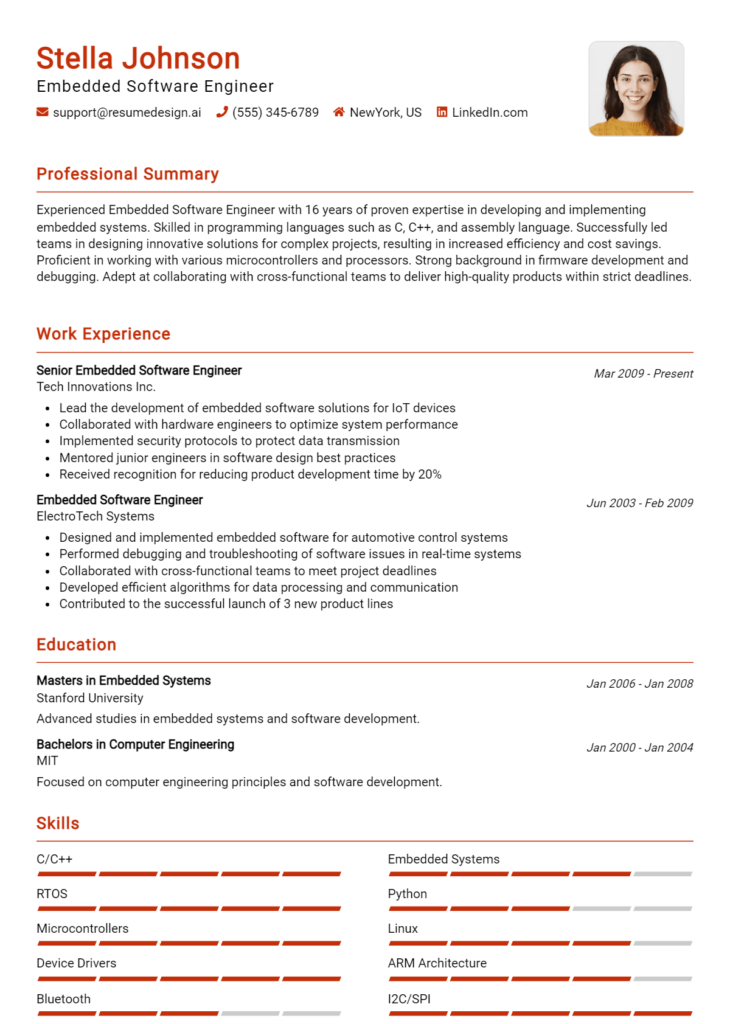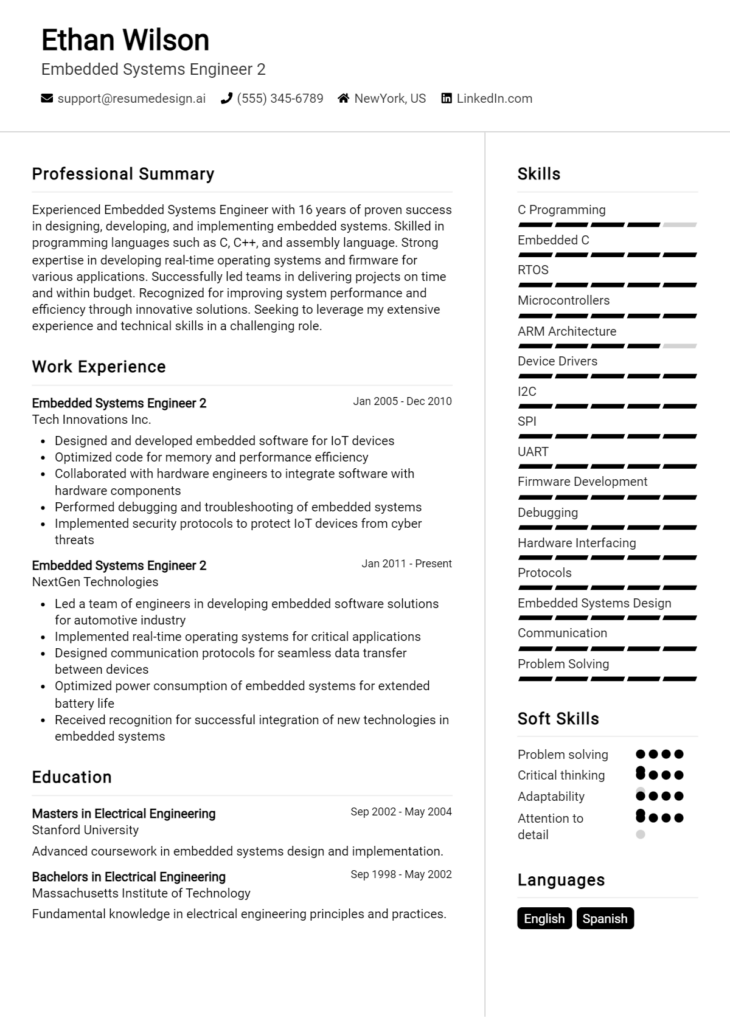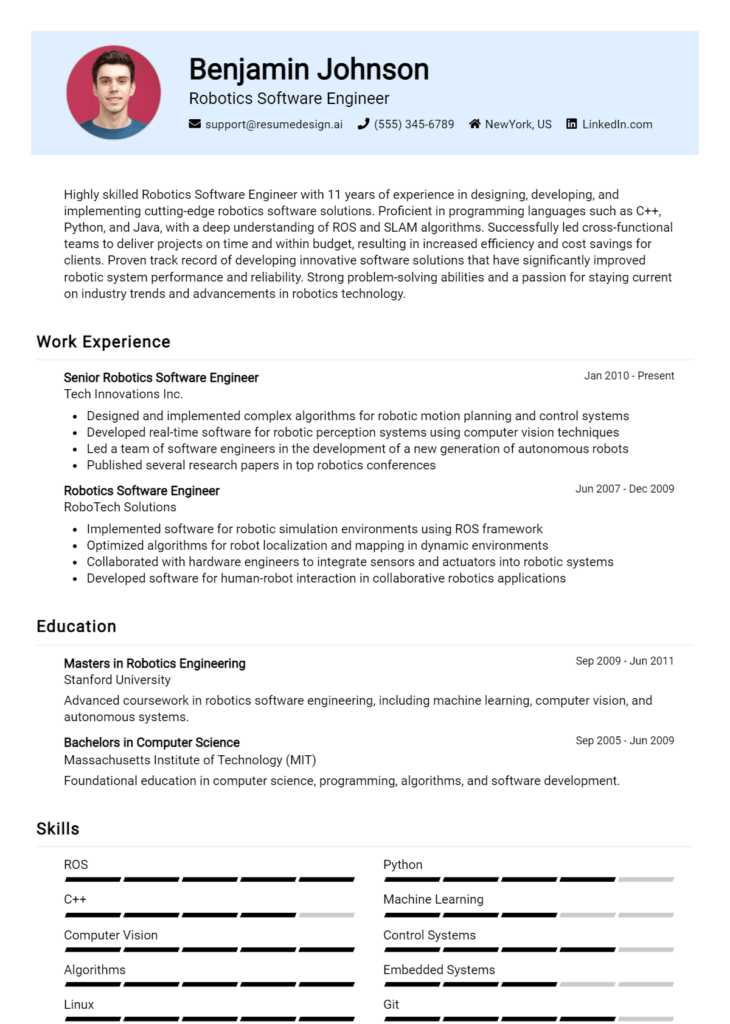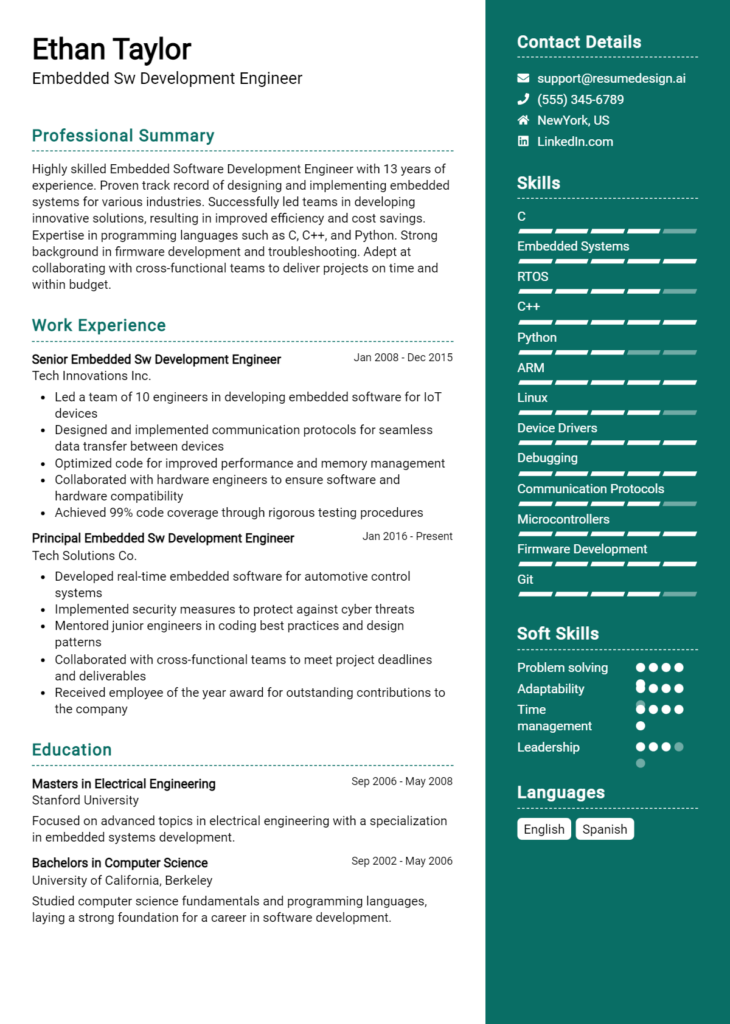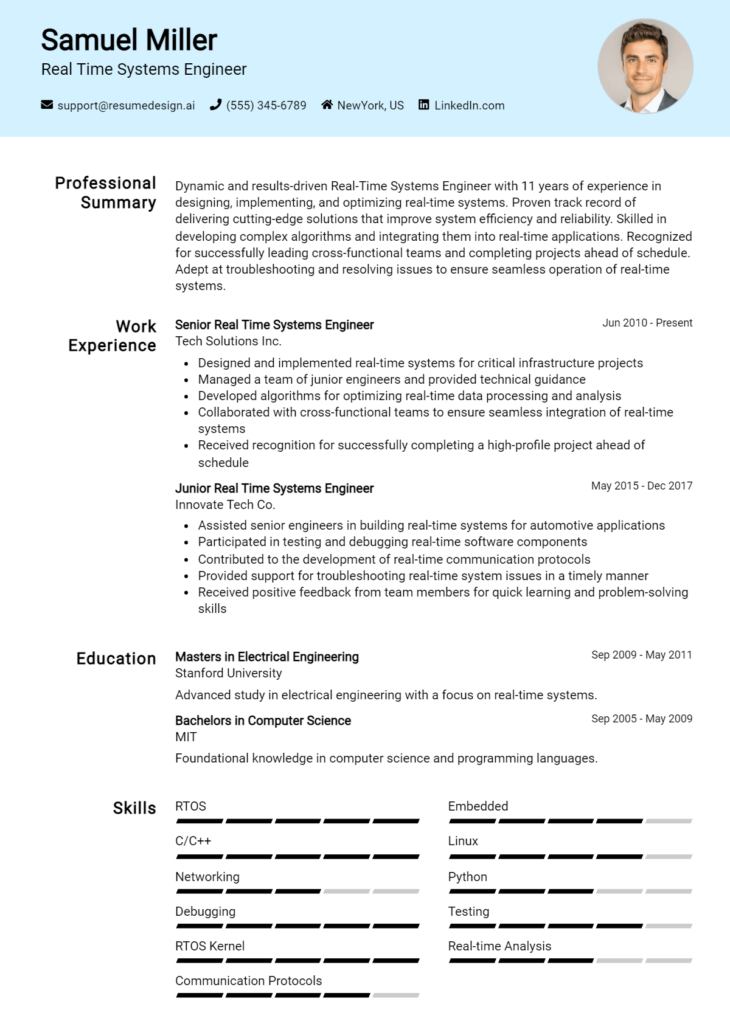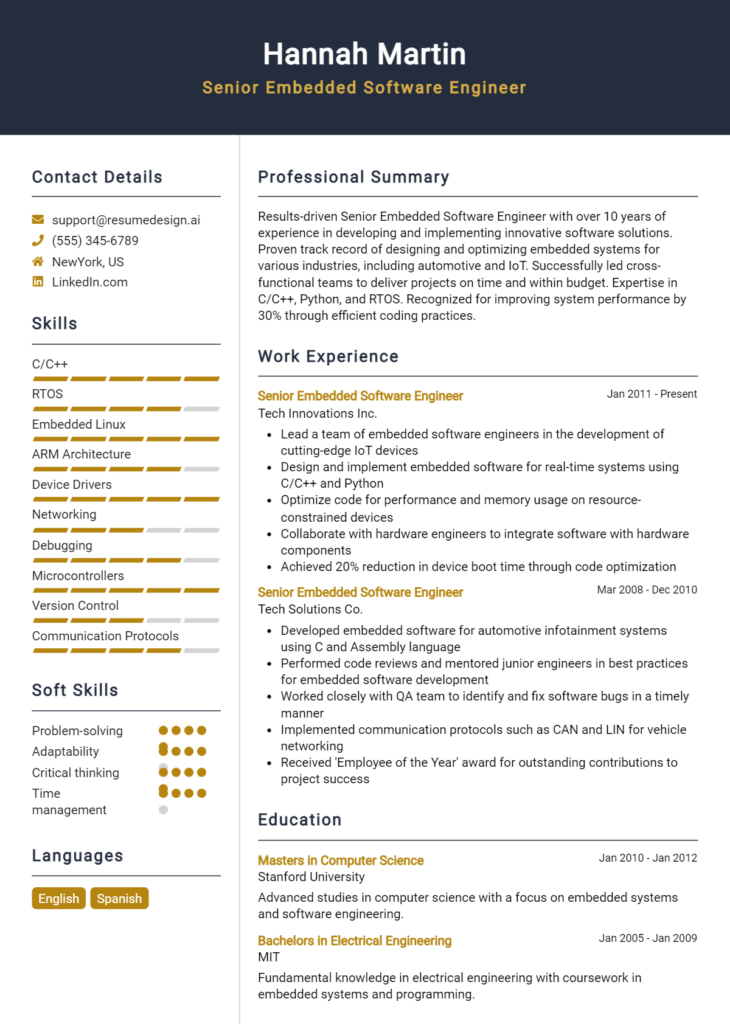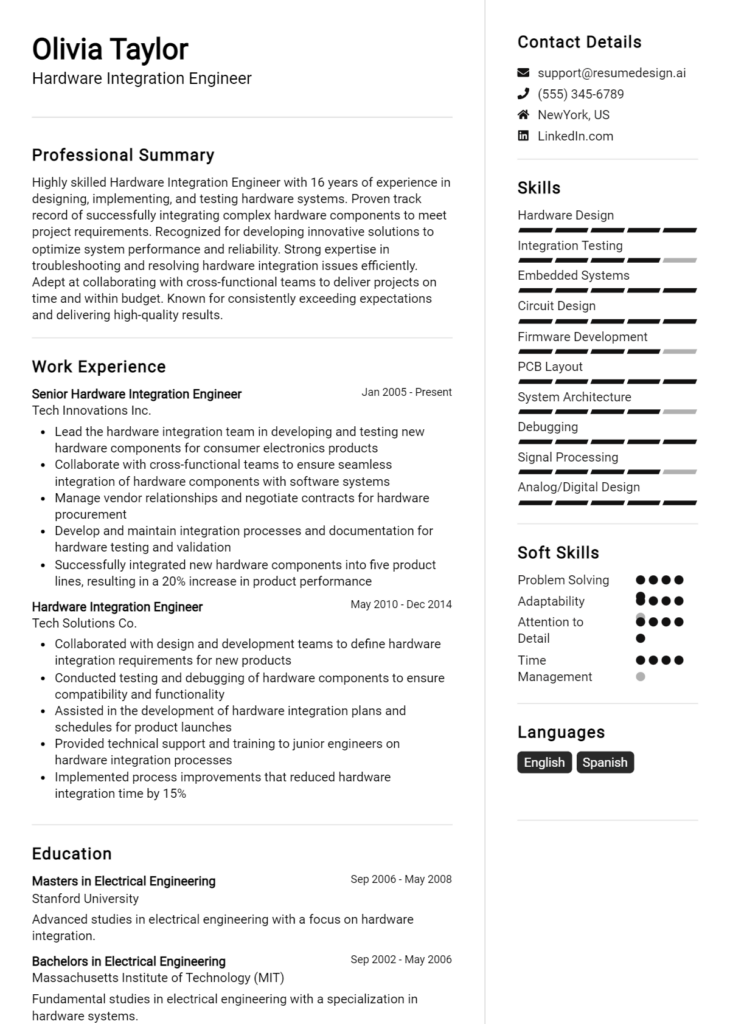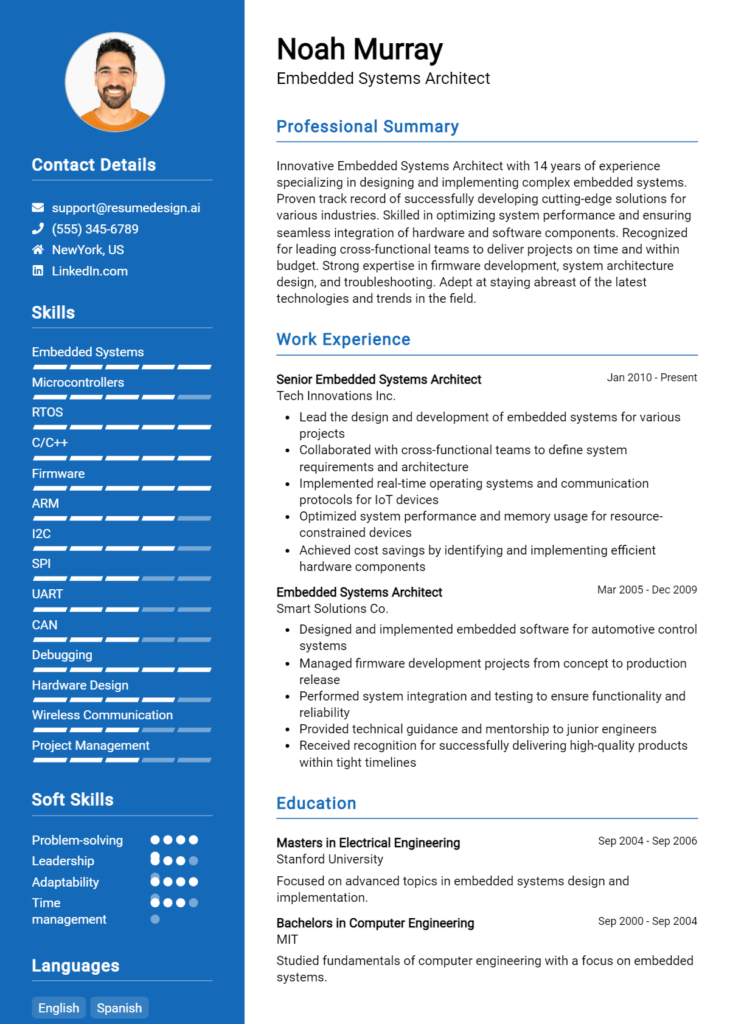Firmware Engineer Core Responsibilities
Firmware Engineers play a crucial role in developing and maintaining embedded systems, requiring a mix of technical expertise, operational knowledge, and strong problem-solving skills. They collaborate across departments, working closely with hardware engineers, software developers, and quality assurance teams to ensure seamless integration of firmware in products. Essential skills include proficiency in programming languages, debugging, and system design. A well-crafted resume can effectively highlight these qualifications, showcasing how they contribute to the organization’s overall goals.
Common Responsibilities Listed on Firmware Engineer Resume
- Design, develop, and test firmware for embedded systems.
- Collaborate with hardware and software teams to ensure compatibility.
- Debug and troubleshoot firmware issues in hardware platforms.
- Document firmware specifications and design processes.
- Optimize firmware performance for efficiency and reliability.
- Implement and maintain version control for firmware code.
- Conduct code reviews and provide constructive feedback.
- Stay updated on industry trends and emerging technologies.
- Participate in system architecture discussions.
- Develop automated tests to validate firmware functionality.
- Support production and field issues related to firmware.
- Collaborate on product roadmaps and timelines.
High-Level Resume Tips for Firmware Engineer Professionals
In today’s competitive job market, a well-crafted resume is essential for Firmware Engineer professionals seeking to make a strong impression on potential employers. Your resume serves as the first point of contact, providing hiring managers with a snapshot of your skills, experiences, and achievements. It is crucial that this document not only showcases your technical proficiency but also highlights your accomplishments in a way that aligns with the specific roles you are targeting. This guide will provide practical and actionable resume tips specifically tailored for Firmware Engineer professionals, helping you stand out in your job search.
Top Resume Tips for Firmware Engineer Professionals
- Tailor your resume for each application by aligning your skills and experiences with the job description.
- Highlight relevant experience, including internships, projects, and previous positions that demonstrate your firmware development expertise.
- Quantify your achievements by including metrics such as performance improvements, cost savings, or successful project completions.
- Showcase industry-specific skills, such as proficiency in programming languages (C, C++, Python), hardware design, and debugging tools.
- Include certifications and relevant coursework that enhance your profile, such as embedded systems or real-time operating systems.
- Utilize action verbs when describing your experiences to convey a sense of proactivity and impact.
- Incorporate keywords found in the job description to ensure your resume passes through applicant tracking systems.
- Keep your resume concise, ideally one page, and focus on the most relevant information that showcases your qualifications.
- Proofread your resume carefully to eliminate any errors in spelling, grammar, or formatting that could detract from your professionalism.
By implementing these tips, you can significantly increase your chances of landing a job in the Firmware Engineer field. A well-structured and targeted resume not only highlights your qualifications but also demonstrates your commitment to the role, making you a more attractive candidate to potential employers.
Why Resume Headlines & Titles are Important for Firmware Engineer
In the competitive field of firmware engineering, a well-crafted resume is crucial for standing out to hiring managers. The resume headline or title serves as the first point of contact and can set the tone for the entire document. A strong headline not only grabs attention but also succinctly summarizes a candidate's key qualifications and areas of expertise in a single impactful phrase. It should be concise, relevant, and directly related to the job being applied for, effectively showcasing the candidate's value proposition right from the start.
Best Practices for Crafting Resume Headlines for Firmware Engineer
- Keep it concise: Aim for a headline that is brief yet informative, ideally no more than 10 words.
- Be role-specific: Tailor the headline to reflect the specific position you are applying for.
- Highlight key skills: Include essential skills that are relevant to firmware engineering, such as programming languages, debugging, or embedded systems.
- Use impactful language: Choose strong action verbs and descriptive adjectives that convey your expertise.
- Include years of experience: If applicable, mention your years of experience to establish credibility.
- Avoid vague terms: Stay away from generic phrases that do not add value or clarity.
- Align with job description: Match the terminology used in the job posting to demonstrate relevance.
- Showcase accomplishments: If space allows, consider mentioning a key achievement that makes you stand out.
Example Resume Headlines for Firmware Engineer
Strong Resume Headlines
"Innovative Firmware Engineer with 5+ Years in Embedded Systems Development"
“Experienced Firmware Developer Specializing in IoT and Device Connectivity”
“Results-Driven Engineer with Proven Track Record in Real-Time Embedded Software”
Weak Resume Headlines
“Engineer Looking for Job”
“Firmware Engineer”
Strong headlines are effective because they immediately convey the candidate’s specific expertise and years of experience, making a lasting impression on hiring managers. They utilize relevant keywords and showcase valuable skills, which can differentiate one candidate from another. In contrast, weak headlines lack specificity and relevance, failing to grab attention or communicate the candidate's qualifications effectively. By avoiding generic titles, candidates risk being overlooked in favor of those who present a clear and compelling narrative right from the headline.
Writing an Exceptional Firmware Engineer Resume Summary
A well-crafted resume summary is essential for a Firmware Engineer, as it serves as the first impression a hiring manager has of a candidate. An impactful summary quickly captures attention by succinctly showcasing key skills, relevant experience, and notable accomplishments tailored to the specific job role. It acts as a hook that encourages hiring managers to delve deeper into the resume, making it crucial that this section is concise, compelling, and directly aligned with the job description.
Best Practices for Writing a Firmware Engineer Resume Summary
- Quantify Achievements: Use numbers and metrics to highlight your successes and impact in previous roles.
- Focus on Relevant Skills: Tailor your summary to emphasize technical skills and competencies pertinent to firmware engineering.
- Keep it Concise: Aim for 2-4 sentences that are clear and to the point, avoiding unnecessary jargon.
- Align with Job Description: Analyze the job posting and incorporate keywords that reflect the desired qualifications and responsibilities.
- Showcase Problem-Solving Abilities: Highlight your experience in troubleshooting and resolving firmware issues effectively.
- Include Industry Experience: Mention any relevant industries you've worked in, particularly if they align with the prospective employer's focus.
- Demonstrate Continuous Learning: Reference any recent certifications or training that showcases your commitment to professional development.
- Use Action Verbs: Start sentences with dynamic verbs to convey a sense of proactivity and initiative.
Example Firmware Engineer Resume Summaries
Strong Resume Summaries
Results-driven Firmware Engineer with over 5 years of experience in developing and optimizing embedded systems for consumer electronics. Spearheaded a project that improved firmware performance by 30%, significantly enhancing product reliability.
Innovative Firmware Engineer skilled in C/C++ and Python, with a proven track record of reducing product time-to-market by 20% through efficient code development and rigorous testing protocols. Passionate about IoT applications and system integration.
Detail-oriented Firmware Engineer with expertise in low-level programming and hardware interfacing, responsible for implementing firmware solutions for automotive applications that resulted in a 25% decrease in system failures over two years.
Weak Resume Summaries
Experienced engineer with a background in firmware development seeking a new opportunity in a tech company.
Firmware Engineer with some knowledge of coding and embedded systems. Looking to grow in a challenging position.
The strong resume summaries are effective because they provide specific details about the candidate's skills and accomplishments, quantify results, and directly relate their experience to the requirements of the role. In contrast, the weak summaries lack specificity and measurable outcomes, making them generic and less impactful, which can hinder a candidate's chances of standing out in a competitive job market.
Work Experience Section for Firmware Engineer Resume
The work experience section of a Firmware Engineer resume is vital as it serves as a comprehensive showcase of a candidate's technical skills, leadership abilities, and commitment to delivering high-quality products. This section is not just a list of past jobs; it highlights how an engineer has applied their expertise in real-world scenarios, managed teams, and contributed to successful project outcomes. Quantifying achievements—such as reduced development time, improved system performance, or enhanced product reliability—adds a layer of credibility and allows potential employers to gauge the candidate's impact. Furthermore, aligning experiences with industry standards ensures that the candidate meets the expectations of prospective employers.
Best Practices for Firmware Engineer Work Experience
- Use action verbs to begin each bullet point, showcasing your contributions effectively.
- Quantify achievements with specific metrics, such as percentages, time savings, or revenue increases.
- Include relevant technical skills and tools that align with job descriptions in your experience entries.
- Highlight leadership roles and team collaborations to demonstrate your ability to work effectively with others.
- Focus on results-driven statements that show how your efforts led to successful project outcomes.
- Tailor your work experience to match the requirements and expectations of the position you’re applying for.
- Use concise and clear language to make your accomplishments easily digestible for hiring managers.
- Incorporate industry-specific jargon where appropriate to reflect your familiarity with the field.
Example Work Experiences for Firmware Engineer
Strong Experiences
- Led a cross-functional team in the development of an embedded firmware solution that improved product performance by 30%, resulting in a 20% increase in customer satisfaction ratings.
- Implemented a new testing framework that reduced the validation time by 40%, enabling faster product releases and enhancing overall system reliability.
- Collaborated with hardware engineers to optimize firmware for power consumption, decreasing energy usage by 25%, which contributed to a greener product line.
- Designed and documented a modular firmware architecture that facilitated code reuse, cutting development time by 15% across multiple projects.
Weak Experiences
- Worked on firmware development tasks with minimal supervision.
- Assisted in various projects related to embedded systems.
- Involved in team meetings to discuss firmware issues.
- Participated in the development of software solutions for different applications.
The examples provided illustrate the difference between strong and weak experiences in a Firmware Engineer's resume. Strong experiences are characterized by specific, quantifiable achievements that demonstrate the candidate's technical expertise and leadership abilities, showcasing their direct impact on projects. In contrast, weak experiences lack detail and measurable outcomes, leaving the reader with a vague understanding of the candidate's contributions and capabilities. This distinction is crucial for making a lasting impression on potential employers.
Education and Certifications Section for Firmware Engineer Resume
The Education and Certifications section of a Firmware Engineer resume plays a critical role in showcasing a candidate's academic background, relevant certifications, and commitment to continuous professional development. This section not only demonstrates the foundational knowledge required for firmware engineering but also highlights any specialized training that aligns with industry standards. By providing details about relevant coursework, certifications, and ongoing learning efforts, candidates can significantly enhance their credibility and better align themselves with the specific requirements of the job role, making a compelling case for their qualifications in the competitive tech landscape.
Best Practices for Firmware Engineer Education and Certifications
- Focus on relevant degrees such as Computer Engineering, Electrical Engineering, or Computer Science.
- Include industry-recognized certifications like Certified Embedded Systems Engineer (CESE) or Certified Software Development Professional (CSDP).
- List relevant coursework that demonstrates expertise in embedded systems, real-time operating systems, or firmware development.
- Highlight any specialized training or workshops that are pertinent to firmware engineering.
- Ensure that the information is up-to-date and reflects current trends and technologies in the industry.
- Use clear formatting and bullet points for easy readability and quick reference by hiring managers.
- Emphasize advanced degrees or additional certifications that may set you apart from other candidates.
- Provide context for certifications, such as the issuing organization and date obtained, to validate credentials.
Example Education and Certifications for Firmware Engineer
Strong Examples
- B.S. in Computer Engineering, University of Technology, 2022
- Certified Embedded Systems Engineer (CESE), 2023
- Relevant Coursework: Embedded Systems Design, Real-Time Operating Systems, Microcontroller Programming
- Advanced Training in IoT Firmware Development, XYZ Training Institute, 2023
Weak Examples
- B.A. in History, Any University, 2019
- Certification in Microsoft Office Suite, 2020
- General Studies Diploma, Community College, 2018
- Outdated Certification in Legacy Programming Languages, 2015
The examples provided highlight the distinction between strong and weak qualifications for a Firmware Engineer. Strong examples reflect relevant degrees, industry-recognized certifications, and specialized training that directly align with the skills needed for firmware development. In contrast, weak examples include degrees and certifications that are not pertinent to the field, suggesting a lack of focus and relevance that may detract from the candidate's qualifications for a firmware engineering role.
Top Skills & Keywords for Firmware Engineer Resume
A well-crafted resume is crucial for a Firmware Engineer, as it highlights not just technical expertise but also the interpersonal and cognitive abilities essential for success in this role. Skills serve as the backbone of your resume, showcasing your proficiency and making you a standout candidate in a competitive job market. By effectively listing both hard and soft skills, you can communicate your capability to design, develop, and troubleshoot firmware while demonstrating your ability to collaborate with cross-functional teams. It’s important to tailor your skills to the job description, ensuring that you align with the employer's needs and expectations.
Top Hard & Soft Skills for Firmware Engineer
Soft Skills
- Problem-solving
- Attention to detail
- Communication skills
- Team collaboration
- Adaptability
- Time management
- Critical thinking
- Creativity
- Analytical skills
- Project management
Hard Skills
- Embedded systems programming
- C/C++ proficiency
- Microcontroller architecture
- Real-time operating systems (RTOS)
- Debugging tools and techniques
- Hardware interfacing
- Firmware development life cycle
- Version control systems (e.g., Git)
- Knowledge of communication protocols (e.g., I2C, SPI, UART)
- Test and validation methodologies
Incorporating these skills into your resume, alongside a strong focus on your work experience, will provide a comprehensive view of your qualifications and help you make a lasting impression on potential employers.
Stand Out with a Winning Firmware Engineer Cover Letter
Dear [Hiring Manager's Name],
I am writing to express my interest in the Firmware Engineer position at [Company Name] as advertised on [Job Board/Company Website]. With a solid background in embedded systems and a passion for developing innovative firmware solutions, I am excited about the opportunity to contribute to your team. My experience in designing, implementing, and testing firmware for a variety of applications has equipped me with the skills necessary to excel in this role.
During my previous role at [Previous Company Name], I successfully led a project that involved the development of firmware for a new line of IoT devices. This experience honed my skills in C/C++ programming and allowed me to collaborate closely with cross-functional teams to ensure seamless integration of hardware and software components. I am well-versed in debugging and optimizing code, which allowed us to reduce power consumption by 30% without compromising performance. My hands-on experience with various microcontrollers and real-time operating systems has prepared me to tackle the challenges presented in the firmware development lifecycle.
I am particularly drawn to [Company Name] because of your commitment to innovation and quality in product development. I admire your recent projects, such as [specific project or product], which align with my interest in [relevant technology or field]. I am eager to bring my problem-solving skills and passion for technology to your team, ensuring that we deliver robust and reliable firmware solutions to meet customer needs.
Thank you for considering my application. I look forward to the opportunity to discuss how my background, skills, and enthusiasms align with the goals of [Company Name]. I am excited about the possibility of contributing to your team and helping to shape the future of your products.
Sincerely,
[Your Name]
[Your LinkedIn Profile]
[Your Contact Information]
Common Mistakes to Avoid in a Firmware Engineer Resume
When crafting a resume for a firmware engineering position, it's essential to present your skills and experience in a clear and compelling manner. However, many candidates make common mistakes that can undermine their chances of landing an interview. Avoiding these pitfalls will help you create a more effective resume that showcases your qualifications and aligns with the expectations of hiring managers in the tech industry.
Lack of Specific Technical Skills: Failing to list specific programming languages, tools, and technologies can leave hiring managers unsure of your qualifications. Be explicit about your expertise in languages like C, C++, or Python, and mention relevant tools such as JTAG or oscilloscopes.
Vague Job Descriptions: Providing generic job descriptions instead of detailing specific accomplishments can weaken your resume. Focus on quantifiable achievements, such as "Reduced firmware boot time by 30% through optimization techniques."
Ignoring Keywords: Many companies use Applicant Tracking Systems (ATS) to screen resumes. Not including relevant keywords from the job description may result in your resume being overlooked. Carefully analyze the job listing and incorporate key terms related to firmware development and embedded systems.
Overemphasis on Soft Skills: While soft skills are important, firmware engineering is a technical role that requires strong technical expertise. Avoid dedicating too much space to discussing qualities like teamwork or communication without backing them up with technical accomplishments.
Inconsistent Formatting: An unprofessional or inconsistent format can distract from your qualifications. Ensure your resume has a clean, modern layout with uniform fonts, sizes, and spacing to enhance readability.
Neglecting Education and Certifications: Firmware engineering often requires a strong educational background. Omitting your degrees, relevant coursework, or certifications (like Certified Embedded Systems Engineer) can give the impression that you're underqualified.
Not Tailoring the Resume: Sending out a generic resume for multiple job applications can hurt your chances. Tailor each resume to the specific position by highlighting the experiences and skills that are most relevant to the job description.
Excessive Length: A resume that is too long can overwhelm hiring managers. Aim for a concise, one-page resume (or two pages for extensive experience) that focuses on the most relevant information, ensuring you make a strong impression quickly.
Conclusion
As we explored the critical skills and responsibilities of a Firmware Engineer, it's clear that this role demands a unique blend of technical expertise and innovative thinking. From designing embedded systems to troubleshooting complex firmware issues, a Firmware Engineer must be adept in programming languages like C/C++, have a solid understanding of hardware-software integration, and be familiar with development tools and methodologies.
We also discussed the significance of continuous learning and staying updated with industry trends, as technology evolves rapidly. Networking and collaboration with cross-functional teams play a vital role in enhancing your career prospects in this field.
With these insights in mind, it’s time to ensure that your resume reflects your qualifications and experiences accurately. An impactful resume can make all the difference in catching a potential employer's attention.
To help you craft the perfect resume, consider using available resources such as resume templates, a resume builder, and resume examples. Additionally, don’t forget to complement your application with a polished cover letter using our cover letter templates.
Take action today to review and refine your Firmware Engineer resume, ensuring it showcases your skills and experiences effectively!

